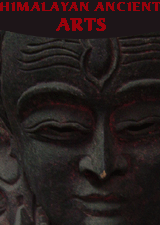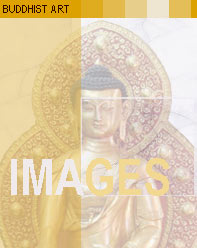Shop
By Type |
 |
|
|
|
|
|
|
|
|
|
|
|
|
|
|
|
|
|
|
|
|
|
|
|
|
|
|
|
|
|
|
|
|
|
|
|
|
|
|
|
|
|
|
|
|
|
|
|
|
|
|
|
|
|
|
|
|
|
|
|
|
 |
 |
Travel Packages  |
 |
 |
Newsletter |
 |
|
|
 |
|
 |
|
 |
|
 |
|
 |
|
 |
|
 |
|
 |
|
|
|
|
Buddha images are symbol supreme. Buddha images provide a serene and reassuring reminder of the basic tenets of Buddhist religion. Just as Buddhist religion is practiced in many different ways, Buddhist image also serves a wide variety of ritual purpose and has different meanings for different people.
Buddha images are such a simple form but can be invested with a huge amount of information, meaning and implication - such is the nature of symbols; they evolve, they are given life. That the Buddha image is cast in the human form gives it a value which can immediately be related to and that it is presented as calm, still and serene human adds extra value.
|
| ............................................................................................................................................................................................................................ |
 |
Buddha images are generally found in four positions or stances: a seated position, a standing position, a walking position and a reclining position. Therefore when we describe the position of a Buddha image, we may call it a seated Buddha image, a standing Buddha image, a walking Buddha image or a reclining Buddha image. |
In keeping with their emphasis on the oldest and most fundamental teachings, Theravada Buddhist produce only a narrow range of Buddhist imagery. Nearly every Southeast Asian Buddha image is made in one of these postures (mudras) that can easily be identified by the position of the hands: |
Dispelling Fear: Hand raised with palm facing outwards and fingers extended in a universal gesture of protection, benevolence, and peace. |
Teaching: Hand raised with palm facing outwards and index finger forming a circle with the thumb. |
Teaching the First Sermon: Both hands together at the chest with fingers on one hand forming a circle representing the “wheel of law” while the other hand touches the wheel to set it in motion (representing the beginning of Buddhist teaching) |
Meditation: Hands resting together on the lap. The gesture symbolizes perfect balance of thought and tranquility. |
| |
| Calling the Earth to Witness: With palm inwards, the right hand touches the ground and “calls the earth to witness” the Buddha's enlightenment. The gesture symbolizes unshakable faith and resolution and is the most common posture for Southeast Asian temple images. |
| Passage to Nirvana: The reclining Buddha representing the Buddha's death. The posture symbolizes complete peace and detachment from the world. |
Offering or Wish Granting: Hand points down with palm facing out. The gesture represents the offering of Buddhist teaching to the world. Sometimes the teaching, and its benefit, is symbolically represented by a small piece of medicinal myroloban fruit. One particularly majestic style of standing offering image with the robes flared out is also known in Thailand and Laos as the “Calling for Rain” posture. Each of these positions can be associated with a moment in the Buddha's life that has an important lesson, although the description of these scenes varies considerably. For example, Burmese temple murals of the moment of the Buddha's enlightenment depict the seated Buddha being challenged by an army of demons summoned by the devil, Mara. The Buddha's hand touches the ground to summon the Earth Goddess who wrings out her hair to unleash a flood that sweeps away the demons. A substantially different version of the story has Mara verbally challenging the Buddha: “Who knows that you have attained enlightenment?” The Buddha touches the ground and calmly replies: “Mother Earth knows.” Seated images are normally based on a lotus leaf, a symbol of spontaneous (i.e. divine) birth. An example of traditional art showing scenes from the Buddha's life is. |
| Perspectives on Use of Buddha images |
While the interpretations and meanings of Buddha images can vary, traditionally all Buddha images were made for religious purposes. Naturally, Buddhists can have strong feelings about the proper and respectful treatment appropriate for Buddha images. Observation of traditional guidelines shows respect for religious teachings and reinforces understanding. Failure to observe traditional guidelines shows disrespect and can be offensive.
The confusing aspect of these guidelines is that in different places there are different traditions for respectful treatment. For example, in Thailand many people wear small Buddha amulets because they like to have the Buddha's presence and sometimes they believe the amulet may provide some supernatural protection. In contrast, many Burmese believe it is improper to wear a Buddha amulet because the wearer shows disrespect by placing his head above the Buddha. In their own way both ideas are respectful. Another example is that the Burmese religious authorities have asked that images of the Buddha not be used in any business advertisement or promotion including book and magazine covers. They considered it improper to associate Buddhist imagery with any commercial activity or product. Many other Buddhists are less strict and accept Buddha images in conjunction with books or other materials about Buddhism. But most Buddhists agree that use of Buddha images in any commercial context other than promotion of Buddhist teaching is disrespectful
In view of the differing traditions, one can broadly say that a proper use of Buddha images is one that shows recognition and respect for the religious meaning. Proper uses could be described as a focus for meditation, a focus of worship, or a reminder of Buddhist doctrines. In keeping with the importance of these images, Buddhists also observe a variety of guidelines about placement of images within their homes:
Location of Buddha images : In Southeast Asia , Buddha statues are normally placed in a location removed from ordinary worldly affairs. Many Thai and Burmese homes have a separate room, alcove, or cabinet for storage of religious images. But some people take another view and place a Buddha image in a place of prominence as a constant reminder of the importance of Buddhist teaching in all aspects of life.
Height of Buddha images: Traditional practice was that images should be high enough that the image's feet were at or above the eye level of people in the room in order to avoid accidentally soiling the images. The Buddha image should be higher than any other figures displayed in the room. Elevation also serves as a reminder of the importance of avoiding pride and ego. From an esthetic point of view, some types of wooden images look less elegant viewed from above when you are looking into the grain.
|
| Selecting a Buddha Images |
| It is not necessary to belong to a Buddhist group in order to study Buddhist teaching and derive comfort or guidance from Buddhist religion and philosophy. It is not necessary for a Buddhist to have a Buddha image. Respectful use of an image can provide a beautiful, positive, and reassuring presence. If you want an image then I encourage you to choose whichever image helps to evoke strengths already inside you. |
| |
| Improper Treatment of Buddha Images |
Improper treatment encompasses any use of Buddha images that does not recognize and respect their spiritual importance. Examples would be:
Decorative use of Buddha images: It can be disrespectful to ignore the spiritual meaning of a statue and acquire it solely for its esthetic properties. Most Westerners have a basic understanding of Christian values and teachings represented in a Jesus image. Hopefully if you own a Buddha image then you have some basic understanding of Buddhist values and teachings.
Kitschy and commercial use Buddha images: It is disrespectful to treat the Buddha's image in the same manner as Hello Kitty. Many Buddhists consider it disrespectful to print Buddha images on common products like clothing, bags, and accessories. It is disrespectful to use the Buddha's image and name in promotion of commercial activity.
Meaningless use of Buddha images: Buddhism is sometimes improperly associated with vague New Age mystical beliefs. Buddhism is a very old religion with a deep and profound scholarly tradition. It is disrespectful to use a Buddha image simply to provide an aura of exoticism and mystery. |
| |
|
 |
|
 |
| |
|
|
| |
| |
|
|
 My
Shopping Basket My
Shopping Basket |
 |
| |
 Best
Seller Best
Seller |
 |
 |
 |
|
Grape Pashmina Shawl |
| Price: US$
71.43 |
|
|
|
| |
 Start
with your budget Start
with your budget |
 |
|
|
| |
 Tell
a friend Tell
a friend |
 |
Tell a friend and win exciting gifts...
Click here
to learn more. |
 |
 |
 |
 |
 |
 |
 |
| |
 |
|